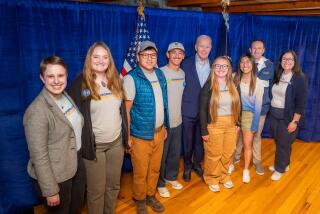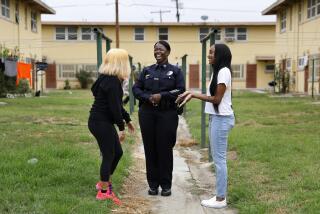Winning Hearts, Minds : Military’s JROTC Programs March Back to the Fore With More Girls Taking Command
- Share via
The marching, flag-raising and single-file roll calls are the same as they were decades ago. But a rebirth of the Junior Reserve Officer Training Corps program has swollen the ranks with high school cadets on a decidedly nonmilitary mission.
Over the last few years, Orange County’s two JROTC programs have increased to 14 programs with 1,558 cadets, and the former bastion of adolescent males is now about one-third female--many of whom are taking command.
“It’s an explosion,” said Col. James H. Ashhurst III, who heads the Army program at Fullerton High School. “The doors have opened and the kids are rushing in.”
Instead of the traditional purpose of preparing students for military enlistment, the program now focuses on good citizenship, community service, self-discipline and leadership skills that can be used after graduation.
It no longer pressures students into joining the military, and only 10% of the JROTC pupils nationwide pursue careers in the armed forces, according to program officials.
“There’s no recruiting object at all,” Ashhurst said. “The Army looks at it as a community service now. It’s a sign of the times. . . . I think parents have realized that they need help teaching their kids respect and discipline.”
Officials from local Navy, Air Force and Marine Corps JROTC programs agree.
“Our mission is to promote citizenship, patriotism, teamwork and the core values, including responsibility, integrity and honesty,” said Col. Phillip Chik, who heads the Air Force JROTC at Buena Park High. “The students seem very eager to learn.
“We went through the hippie era in the 1970s, the ‘me, me, I, I’ period in the ‘80s and I think we’re now seeing more concern for your fellow man and patriotism in the ‘90s. It’s a rebirth,” Chik said.
Along with the new attitude, the program has become increasingly popular with female students, who dominate the highest-ranking positions in each of the JROTC battalions in Orange County.
Take Kristina Hunt, for example.
The 17-year-old Fullerton High student first joined her school’s JROTC as an alternative to a physical education course when she was a freshman.
But, “after a while, it became my thing,” said Hunt, now a senior. “They don’t force you to go into the military, but you can’t just goof off. . . . It’s very strenuous. You really learn to become better citizens and I’ve learned how to motivate the cadets.”
Hunt now holds the top post:cadet lieutenant colonel. After a formal ceremony last week, she became the fifth girl to earn the rank at Fullerton High.
The position has a new face twice a year and, although more boys are enrolled in the Fullerton program, only one has earned that rank in the last three years. Ashhurst said the sequence, beginning in 1993, has been: girl, boy, girl, girl, girl, girl.
“In the JROTC, if you can lead, then you’re going to be in charge,” said Lt. Col. James F. Madison, director of the Army JROTC programs in California, Arizona, New Mexico and Nevada. “The females have taken the reins of command and have done extremely well.”
Says Fullerton High Cadet Daniel Estrada: “It’s not really a big deal. I’ve learned girls can do the same job guys can do.”
Estrada, 17, who has been in the program for the past three years, said it is more then just marching. And, regardless of gender, Estrada and other cadets said they are learning valuable lessons about life.
“Before I joined the program, I was so irresponsible in school and at home,” Estrada said. “I was always goofing off. But now, I clean my room, do my homework and listen to my grandparents. I’m responsible.”
Parents and educators were behind a congressional effort that led the U.S. Army, Air Force, Navy and Marine Corps to begin expanding their JROTC programs nationwide four years ago as an alternative to gang involvement, officials said. They became so popular that the programs have more than doubled throughout the country.
In Orange County, Santa Ana High School’s 26-year-old JROTC program was once the only one of its kind here. Then 10 years ago, a program started at Fullerton High. Since 1992, 12 others have sprung up in the county.
“It’s a whole new image and mentality we’ve got and parents and administrators want us in their students’ schools because they recognize the value of what we’re teaching,” said Air Force Capt. Lorin Akers, who oversees JROTC programs in Southern California. “It’s not just drilling and marching any more.”
Added Ashhurst: “Everybody’s trying to figure out what to do with teenagers these days. The JROTC is a good alternative to gangs and drugs. I don’t think we’d be multiplying as rapidly as we are unless many people in our society felt it was a good program.”
Former Cadet Lt. Col. Elizabeth Rhein, 16, of Fullerton High, said the program had a lasting impact on her in a way that has left her grateful.
“My communication skills improved, I learned how to carry myself with lots of confidence and I’ve got organizational and leadership skills that will help me the rest of my life,” Rhein said. “A lot of kids have gone through the program, coming out looking a lot better. I did and my parents are proud. They realize it was something that really, really did me good.”


